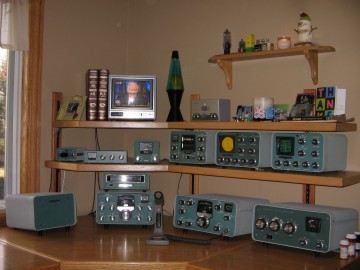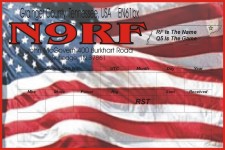My first radio was the dream rig of my youth; the Heathkit Twins – an SB-401 transmitter and SB-303 receiver. Purchased some 30 years after their introduction, they were a sight to behold. While their aesthetics were like-new, both needed much internal TLC. I thoroughly enjoyed the restoration and decided to put together an entire station. You see, as a boy, I grew up just a bicycle ride from a Heathkit store. They had a complete ham shack in the corner, with every receiver, transmitter, transceiver, and accessory available from the Heathkit catalog. Each week, hours were spent in that corner marveling at the newly-introduced SB Series which sent tingling sensations through my body each time the squelch broke with a signal.

- Desk:
- SB-600 Speaker
- SB-303 Receiver and SB 650 Digital Frequency Readout
- SB-401 Transmitter
- SB-200 Linear Amplifier
- Above:
- HD-1410 Electronic Keyer
- HD-15 Phone Patch
- HM-2102 Wattmeter
- SB-630 Station Console
- SB-620 "Scanalyzer" Panadapter
- SB-610 Station Monitor
- SB-220 Linear Amplifier under main operating position
The Heathkits were beautiful and fun, but they certainly were not state-of-the-art. I thought it was time to upgrade to a 21st Century radio and chose the Kenwood TS-2000 as it included 2 Meters and 70 Centimeters. The radio turned-out to be an extraordinary VHF/UHF rig, but without mods, was deaf as a post, particularly on HF. I also purchased the Yaesu FT-1000MP Mark V and matching FTV-1000 6 Meter transceiver. Now I had three stations - a Vintage station as well as dedicated HF/6 Meter and UHF/VHF stations setup in two operating positions!
UHF/VHF
In Northern Illinois, I was blessed with a QTH located upon a ridge with slopes that gently swept away for up to 30 miles. It was a DXer's dream. I was also lucky enough to befriend a man who became my Elmer and friend – Ron, W9ZIH; a pioneer in UHF and up. Through his mentoring and urgings, I constructed a UHF/VHF station that performed well, far beyond my wildest dreams. This station consisted of the Kenwood TS-2000, now, with the PIN diode mod, teamed with W9ZIH preamps for 2 and 432 to help the ears. For talking, I modified an AM-6155 power amplifier for 2 meters, and used a 2 x 4CX250 W9ZIH amp for 432 (ultimately replaced by another AM-6155 modified for this band). Outside, were a pair of Cushcraft A719B’s nested between stacked Cushcraft 215WBs at 70’. The boom of these arrays was clamped to a plate whose welded pipe mounted in a Yaesu G-5500 Alti-Azimuth rotor to provide vertical as well as horizontal polarization. The combination was fantastic.

SSB on 2 Meters and 432 was just too easy, so I found much joy on 2 Meter Simplex much to my Elmer’s dismay. On so many summer evenings, I held QSO’s on 155.52 MHz with a group in Kokomo, some 220 miles away. We spoke with ease and the Locals thought I was messing with them. I longed for openings on weekend mornings, where I would join Simplex conversations states away. One Sunday morning, there were two gentlemen I hadn’t heard before, so I dropped the Call on them. They were east of Pittsburg, PA, more than 440 miles away. We chewed for a half an hour before the Locals began to step on them. I don’t think they believed I was really in Illinois until they got my QSL cards.
Ron, was always urging me into uncharted territory. Amateur Television was next. I found a 2W ATV transceiver and a D1010 at a hamfest, bought a remote-control camera, dug up my old video equipment, and got on the air. ATV turned-out to be very technically challenging. The ZIH UHF 4CX250 amp had to be broadbanded to accept the NTSC bandwidth, monitors proved finiky, finally settled on a vintage Zenith that performed very well (seen above the Heatkits). Of course, there was the obligatory receive preamp and a SAW filter that Ron found somewhere. I was so into it I even found myself writing an article for Amateur Television Quarterly. Phew! For all my work however, I never could perform as well as my friend Ron nor Dwight, WA9EUN (SK). These guys were hard-core, had been around the block way too long, and were way too smart. They truly had ATV superstations.
HF/6 Meters
The Mark was fed into the Heathkit SB-220 outputting to various dipoles and arrays, while the 6 Meter transverter operated barefoot at 200 Watts into a simple dipole (after all, it WAS 6 Meters!). For HF, I had wire everywhere and a Mosley PRO-67-C-3 at 80’. The Yagi was a PIA. It was big and heavy, with no way to get to the feed point without dropping the tower and standing on a 12' ladder. It was also a big disappointment, as the wires out-performed the antenna, especialy on 40 Meters where I wanted it most. To all 40 Meter buffs that want gain or F/B, try phased dipoles using an LC Network for phasing. Even at 40' they will blow you away. Overall, it was a really great station, I wasn't a Contester, my code skills were embarrassing to me, and it seemed Phone was nothing but rag-chewers and that bored the Hell out of me. I did get into ESSB as it allowed me to modify my radio (YES!), but the group did not seem cohesive at the time and the required bandwidth ticked-off other hams that just had to sidle up against an ESSB conversation. I can say that the audio was GREAT!




